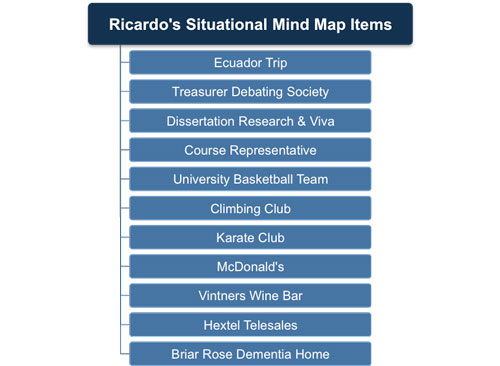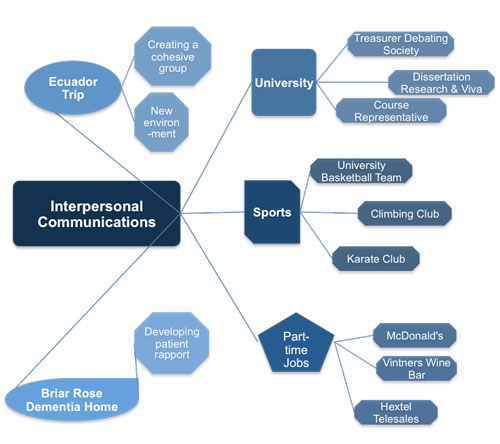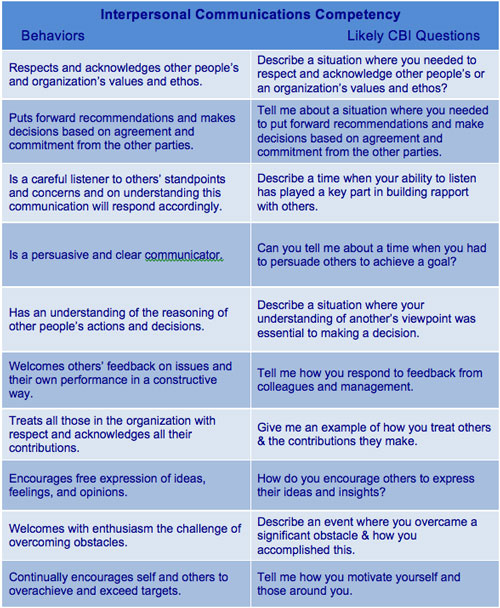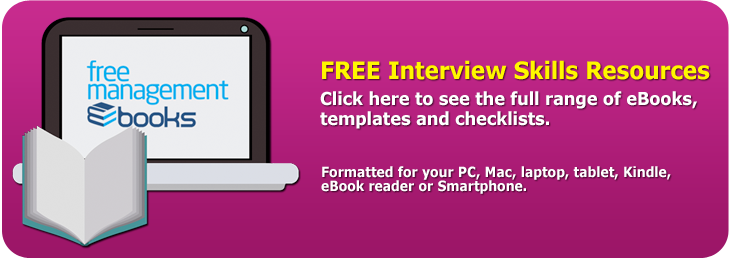STAR Method
The STAR method is a simple four-stage process that is ideal for those just starting out in a career or those who are switching careers. STAR enables an individual to quickly identify situations or events that allow them to demonstrate the required competencies.
 |
STAR is technique that you can use once you have identified the key competencies of the role. The letters stand for:
Situation - select a recent situation or challenge that will demonstrate the asked-for competency.
Task - describe what it is you had to achieve.
Action - give a concise and structured description of what you did, your reasons for these actions, and what alternatives you considered and rejected.
Results - what did you achieve and was it the desired outcome? Would you alter your actions if faced with the situation again and, if so, why?
In this example, Ricardo, a university graduate with no full-time work experience, needs to prepare for a graduate management assessment. The first part of his preparation involves creating a 'situational mind map.' Because he does not have appropriate work experience he will need to use the competencies he has gained whilst at university, in part-time and charity work, field trips, and as a member of sports and social clubs.
 |
Each item represents something he has been involved with over the last three years. (Prior experiences are inappropriate because they will not show the right level of each competency for a management graduate.)
Ecuador trip - climbing Antizana peak with a group of climbers he'd never met before. He needed to assess the other members and form a team. Competencies include communication, planning & organizing, resource management, coaching, and decision-making.
University - his role as course representative and treasurer of the debating society shows leadership and stakeholder management plus customer-focused competencies. Additional competencies such as change agent and strategic thinking are illustrated by his dissertation research and viva.
Part-time jobs - his roles in McDonald's and Hextel Telesales required him to adapt to hierarchical and highly structured environments. Competencies included being customer focused, communicating with co-workers, and being self-motivated.
Sports - each of these activities and his track record show his ability to work comfortably as a member of a team or on his own. Representing the following competencies: continual improvement, interpersonal communications, leadership, decision-making, mentoring, and coaching.
Briar Rose Dementia Home - volunteer work and fundraising at the home for two years. Competencies shown are interpersonal communications, customer focused, organization, continual improvement, and personal development.
Having identified each item that contributes to one or more competencies in the free template management competency framework, he is now ready to produce a mind map for each of the twelve management competencies, demonstrating their associated behaviors.
From the documents he has been sent and his own research he has discovered that 'interpersonal communications' is an essential competency for the role. It is defined as:
Builds and maintains good working relationships throughout the organization and externally.
Develops a sound understanding of others and their needs to ensure a good working relationship.
A detailed description of how to determine the key competencies of a role is provided in our free eBook 'Interview Preparation'.
The diagram below shows you how Ricardo has created a situational mind map for the competency 'interpersonal communications.' For each box he has an event or situation that enables him to demonstrate the appropriate level of this competency.
 |
Then from the competency framework template and the listed behaviors for this competency he is able to write potential questions he will face in a CBI as part of his graduate assessment. The table below shows how to translate the behavior statements into a CBI question.
 |
Having identified potential questions Ricardo now uses the STAR method to help him construct his answers.
Looking at the question - 'Describe a situation where you needed to respect and acknowledge other people's or an organization's values and ethos' - Ricardo looks at his mind map to find the situation that illustrates this competency and its required level to construct his answer.
To do this as efficiently as possible and to make sure that he is choosing the best example, Ricardo works systematically through his mind map considering this behavior in relation to each of the places he has worked or studied, the clubs, teams and societies he has belonged to and the expedition he undertook to Ecuador.
After a few minutes consideration and having made some quick notes on the mind map, he decides that there are two occasions where he has had to go out of his way to accommodate other people's values and culture. The backpacking trip to Ecuador obviously required it because of the difference in the way of life there, and this could be used as a good example in an interview. The second occasion was working in McDonalds which also has a culture and ethos of its own - one which Ricardo initially found quite difficult to adjust to.
Ricardo marks both of these as possible examples and then tackles them one at a time. He imagines the interviewer asking first question:
"Tell me about a time when you had to respect and acknowledge other people's or a organization's values and ethos?"
He mentally answers the question using the Ecuador trip as an example. He then repeats the process using the McDonalds example. Thinking about it, he decides that the McDonalds example works better. It is work related, it represented a culture and ethos that he really had to 'buy into' for 40 hours per week rather than just admire from a distance, and the strict hierarchy and prescriptive nature of the work represented a significant challenge to someone with a liberal arts background like himself.
Having decided to go with this example, Ricardo now needs to frame his answer according to the STAR acronym. This stands for Situation, Task, Action and Result. By framing his answer in this way, Ricardo ensures that his answer is clear and logical, but most importantly that it includes the all important 'result' or 'pay-off' which is what distinguishes a great answer from an indifferent one.
Situation or Task - Define the situation or 'set the stage".
"I worked in my local McDonalds for three months to help pay for my final year at university. Initially I found the strict hierarchy and prescriptive nature of the work alien to anything I'd experienced up to that point in my life and I did wonder if it was really necessary to have such inflexible procedures for everything."
Action - Describe the action that you took/initiated. This response should illustrate the specific skills you used.
"However, I accepted that their way of doing things had evolved for a good reason and I did my best to do everything the 'McDonalds way' even when I couldn't really see why they did it like that."
Result - Summarize the outcome.
"When I'd been there for a few weeks, it all started to make sense. Their way of doing things has been developed to take account of a high staff turnover in a business that prides itself on the consistency of its products and services. When I did make some suggestions to improve efficiency, I made sure that they took full account of the prevailing culture. As a result, these suggestions were taken seriously and some of them were implemented."
This answer would demonstrate that whilst Ricardo is has the intellect to question the values and ethos of others, he also has the maturity to reserve making a judgement until he is in possession of the full picture. This answer definitely 'ticks the box' and would count positively towards the competency 'Interpersonal Communications' at 'Management' level.
The other vital attribute that this answer has is that it is based on the truth and will survive any amount of scrutiny. If the interviewer decides to ask a series of quick supplementary questions to verify this, for example:
"What suggestions did you make?"
"Which were implemented?"
"Were they implemented outside of your own branch?"
Ricardo will not hesitate or dissemble when answering them. As has been pointed out earlier in this section, if the interviewer has doubts about your honesty then you are very unlikely to be successfully selected - no one will employ a person that they don't trust, no matter what other skills they may have.
As you can see, the STAR method provides a structured way of identifying the best scenario to base your answer on. You can then go on to formulate a narrative that works well as an answer to a competency-based question.
This process is time consuming and needs a lot of thought; it is not something that should be done the night before an important interview. Ideally, you should work through it over a period of a few days, tackling one competency at a time and revising previous items as better examples occur to you.
The good news is that you don't usually need to make frequent changes to this information, although you may need to update it following a significant event such as completing a project or taking on a new responsibility.
In addition, most of the competencies you will be asked questions about will be the same or similar provided that you are applying for the same type of job in the same industry.
You may also be interested in:
Competency Based Interviews | Competency-Based Questions | STAR Method | SOARA Method.


